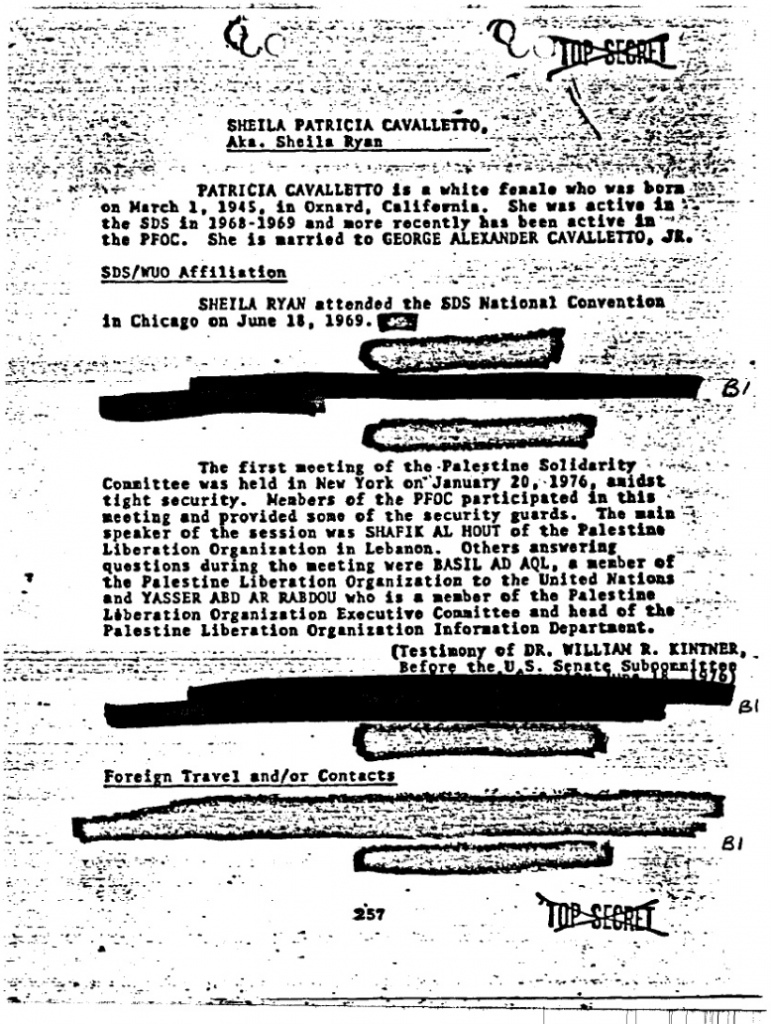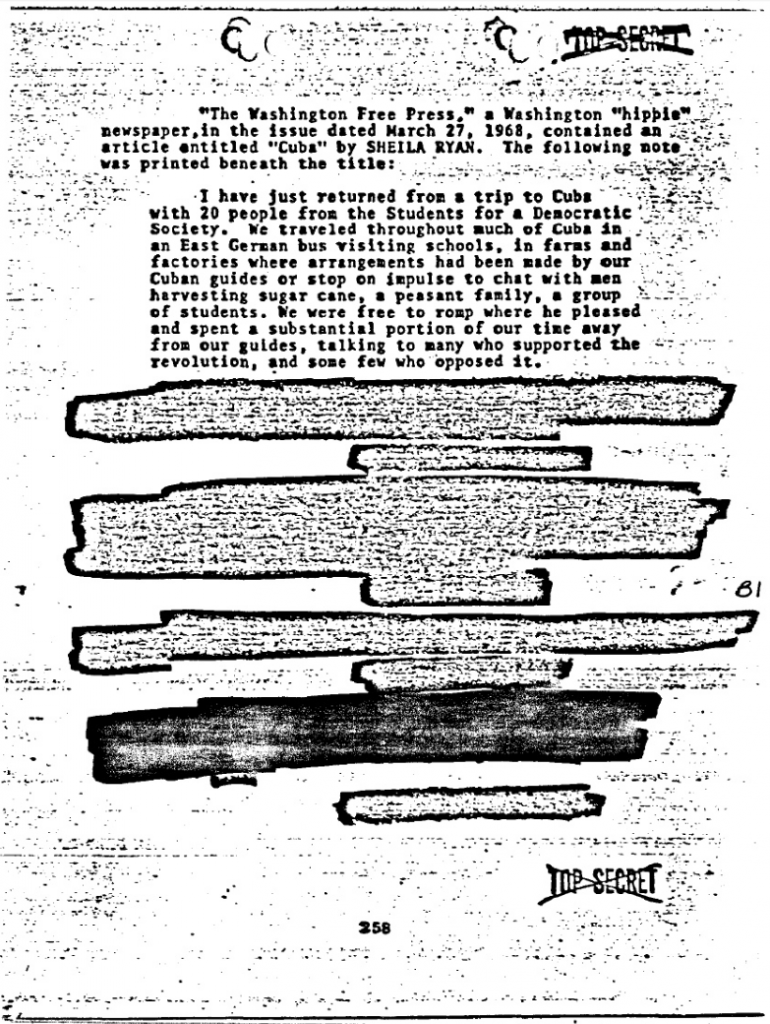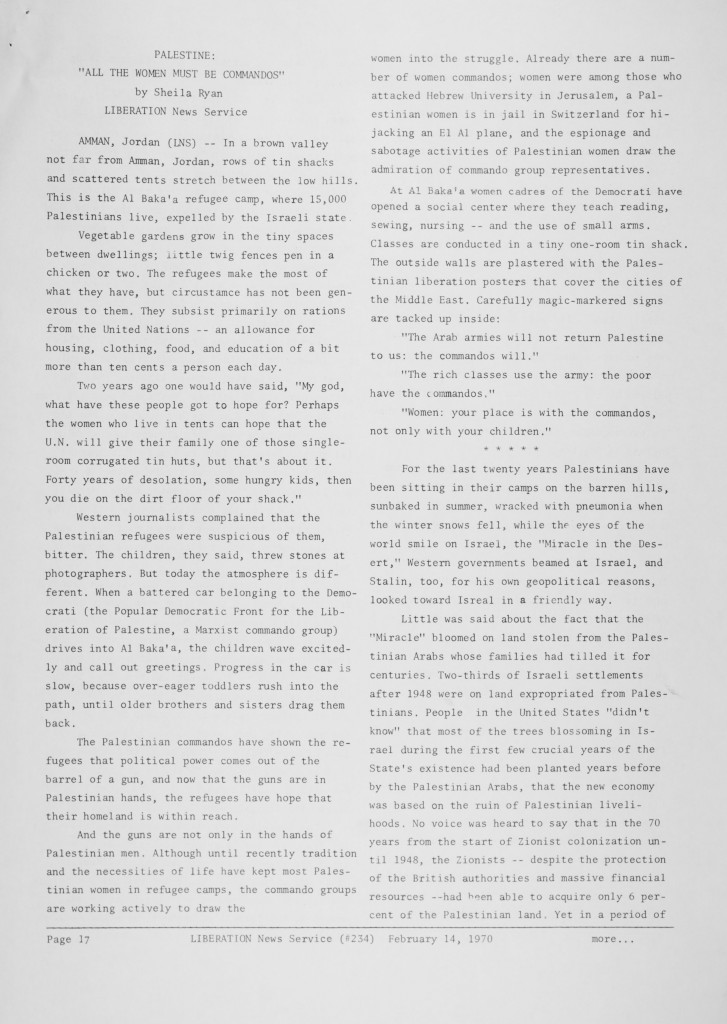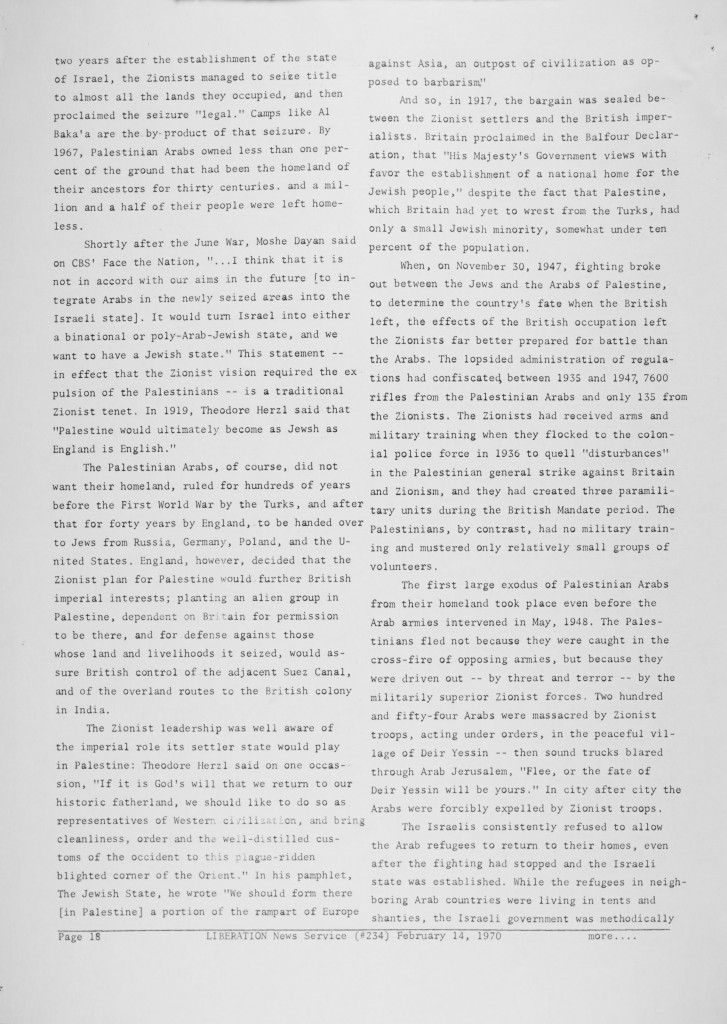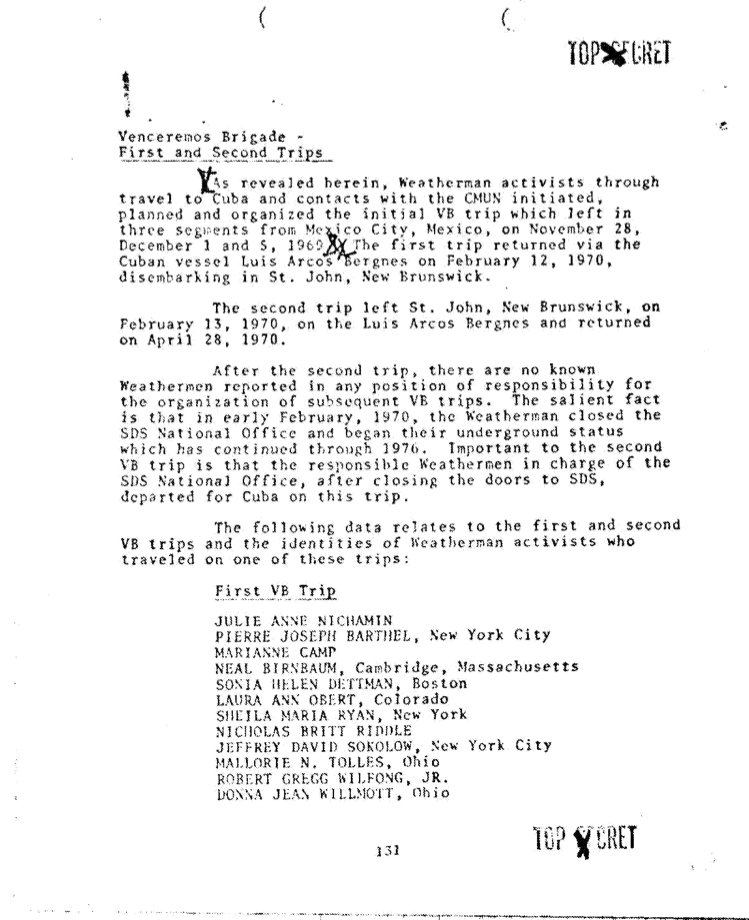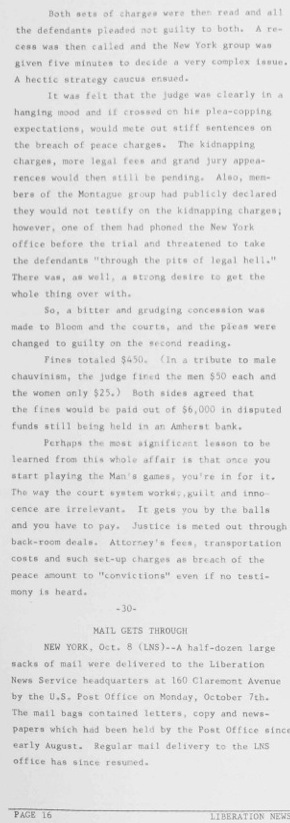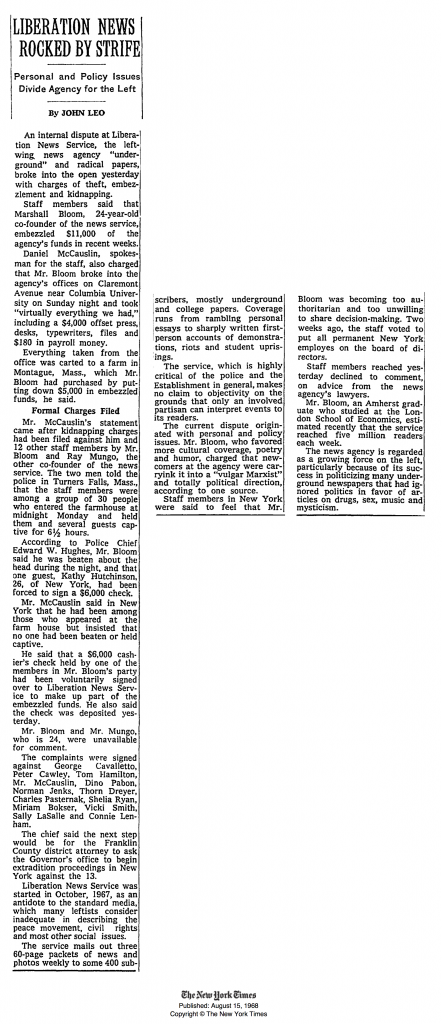Andy Marx made these comments at Sheila’s memorial:
Category Archives: Left Press
Alan’s Remembrance: “The Sister I Never Had”
Alan Howard spoke at Sheila’s memorial, describing Sheila’s intense level of connection and caring for the people around her:
1976 FBI Report: Agent of the Weather Underground
In 1976, the FBI assembled a report on the Weather Underground that included Sheila and George on the same list as Bill Ayers and Benardine Dohrn.
This is inaccurate. Sheila and George were never members of the Weathermen or the Weather Underground.
However, because they had known and worked with a number of the SDSers who chose to go underground as the Weather Underground, and because of their ongoing activism, they were included in FBI write-ups of possible Weather Underground associates.
Sheila disagreed with the “small vanguardist strategy” adopted by the Weathermen, which she saw as undermining the efforts to build mass movements in the United States that could bring about real political change.
Eventually released under the Freedom of Information Act, the document is available through the FBI’s web site.
Here’s the FBI’s profile on Sheila as part of the Weather Underground network:
1970: “All The Women Must Be Commandos”
1970: To Cuba with Venceremos Brigade
The FBI seems to list Sheila as part of the Venceremos Brigade to Cuba in early 1970, under an alias, “Sheila Maria Ryan”.
However, George says this didn’t actually happen — she only went in 1968, not 1970.:
Underground Press Syndicate: “Sexism Must Be Eliminated”
Sheila advocated for women to take an equal role in the underground press:
In July 1969… Ann Arbor, Michigan… a four-day UPS [Underground Press Syndicate] conference that was hosted by a commune called Trans-Love Energies Unlimited. … the group managed to discuss many of the main issues that were roiling the underground press in this period. One focal point was sexism; a group of women’s liberationists complained that they were treated shabbily by their colleagues, and despite heavy opposition from the White Panthers, LNS’s Sheila Ryan was able to spearhead the passage of a three-point resolution proclaiming: “(1) sexism must be eliminated from the underground paper’s contents and ads, (2) undergrounds should publish articles on women’s oppression, (and) (3) women should have full roles in underground papers’ staffs.”
— From Smoking Typewriters, John McMillian, Oxford University Press, 2011, page 120-122.
A slightly longer version of this resolution is given in the Wikipedia entry on UPS which sounds like Sheila’s composition;
1. That male supremacy and chauvinism be eliminated from the contents of the underground papers. For example, papers should stop accepting commercial advertising that uses women’s bodies to sell records and other products, and advertisements for sex, since the use of sex as a commodity specially oppresses women in this country. Also, women’s bodies should not be exploited in the papers for the purpose of increasing circulation.
2. That papers make a particular effort to publish material on women’s oppression and liberation with the entire contents of the paper.
3. That women have a full role in all the functions of the staffs of underground papers.
LNS member Andy Marx accompanied Sheila to the UPS meeting and tells the story this way:
We went to this meeting … it was this really weird thing, it was out on this sort of farm outside of Ann Arbor, with — one of the organizing groups was the White Panther Party, who fancied themselves to be the equivalent of the Black Panthers, so there’s this sort of wasted looking guy named Fuzzy, that was his nickname, with a 22 and something — sitting at the end of the driveway, as if he was going to … fight them off [if the police came].
The papers, a lof them that were represented there were all into this — a lot of them survived on advertising that was full of sort of misogynistic images of women, and Sheila, just in this non-confrontational but absolutely persistant — I mean, she just wouldn’t let go of it — carried on this long debate / discussion, and it ended up they adopted a position saying that the papers should, both in their content page coverage and in their advertising pages, they should repudiate sterotype and demeaning images of women.
… So she was dealing with … these stoned guys who were sort of proclaiming about being too hard-core political, and being uptight about this — “so we have pictures of naked chicks, you know, what’s the problem, you know, we all want to be free.” … And she managed — it was impressive — to communicate across the board.
Targeted by the FBI and CIA
LNS was the target of government attention and a sustained campaign of dirty tricks.
As summarized in an article on “The Press” published by “Forgotten History”:
The Liberation News Service was an alternative wire service that spoke out against the war in Vietnam. It was very critical of U.S. involvement and provided a service to the mainstream press by providing sources of information for them. The reality was that the mainstream press was so out of touch, that they needed the content and contacts that services such as the Liberation News provided. During the war, the Liberation News became the target of the CIA, the FBI and Military Intelligence. The FBI went so far as to break into their offices, destroy their equipment and set fire to the building. The CIA set up informants to spy on the service, which is forbidden under the CIA’s charter, while the FBI moved to discredit them.
Further details were provided in an article for the Columbia Journalism Review:
The government’s offensive against the underground press primarily involved three agencies – the CIA, the FBI, and the Army. In many cases, their activities stemmed from what they could claim were legitimate concerns. The CIA’s Operation CHAOS, for example, was set up to look into the foreign connections of domestic dissidents; however, it soon exceeded its mandate and became part of the broad attack on the left and on publications that were regarded as creating a climate disruptive of the war effort. At its height, the government’s offensive may have affected more than 150 of the roughly 500 underground publications that became the nerve centers of the antiwar and countercultural movements.
A telling example of this offensive was the harassment of Liberation News Service, which, when opposition to the Vietnam War was building, played a key role in keeping the disparate parts of the antiwar movement informed. By 1968, the FBI had assigned three informants to penetrate the news service, while nine other informants regularly reported on it from the outside. Their reports were forwarded to the U.S. Army’s Counterintelligence Branch. where an analyst kept tabs on LNS founders Ray Mungo and Marshall Bloom, and to the Secret Service, the Internal Revenue Service, the Navy, the Air Force, and the CIA. The FBI also attempted to discredit and break up the news service through various counterintelligence activities, such as trying to make LNS appear to be an FBI front, to create friction among staff members, and to burn down the LNS office in Washington while the staff slept upstairs. Before long, the CIA, too, joined the offensive; one of its recruits began filing reports on the movements of LNS staff members while reporting for the underground press to establish his cover as an underground journalist.
…
During the 1971 May Day antiwar demonstration in Washington, Ferrera took photographs and reported on the event for College Press Service, an antiwar syndication service; he may well have been the agent mentioned in the Rockefeller Commission’s hearings on the CIA as having covered the demonstration for the agency. He also appears to have been the source of two reports to the CIA regarding staff members of Liberation News Service. In late April, when Ferrera was still working in the Quicksilver office, an LNS editor stopped in to ask if LNS staff members who planned to come down from New York for May Day could lodge there. A CHAOS informant’s report, dated April 25 and released to LNS editor Andrew Marx under the FOIA, refers to this visit. A second report lists all LNS staff members who attended the May Day demonstration.
…
In some cities, when direct attacks proved unsuccessful, the government set up its own phony news service which, so long as it was unexposed, provided a means of penetrating the left; once exposed, it cast suspicion on legitimate underground reporters and helped to create a feeling of paranoia. … Meanwhile, on the East Coast, the FBI operated New York Press Service under the direction of Louis Salzberg. NYPS offered its services to left-wing publications at attractive rates, soliciting business with a letter that read, in part: “The next time your organization schedules a demonstration, march, picket or office party, let us know in advance. We’ll cover it like a blanket and deliver a cost free sample of our work to your office.” NYPS’s cover was blown when Salzberg surfaced as a government witness in the Chicago Seven trial, during which it was disclosed that he had been an FBI informant.
The New York field office shrewdly turned this setback into a means of casting suspicion on Liberation News Service. The office prepared an anonymous letter, copies of which were sent to newspapers and antiwar groups, accusing LNS of being an FBI front. “Lns [sic] is in an ideal position to infiltrate the movement at every level,” the letter stated. “It has carefully concealed its books from all but a select few. Former employees have openly questioned its sources of operating funds, I shall write to you further on Lns for I (and several others) are taking steps to expose this fraud for what it really is – a government financed front.”
— From “Sabotaging the Dissident Press: The untold story of the secret offensive waged by the U.S. government against antiwar publications”, by Angus Mackenzie, Columbia Journalism Review, March-April, 1981, pp. 57-63. (Archived at UTWatch.) (PDF Version) (Wayback Cache at Archive.org)
1969: “Panthers & Pigs”
This article by Sheila was printed in the April 10, 1969 edition of the SDS New Left Notes:
Panthers & Pigs: New York
by Sheila Ryan
Liberation News Service
NEW YORK, NEW YORK (LNS) — “SMASH PANTHER BOMB PLOT!* “COPS: CUBA HELPS PANTHERS PROWL,” and “SEEK PANTHER LINK TO STOLEN YOUTH FUNDS” displaced the headlines of the previous week describing a city in disintegration— hospitals being closed because adequate funds were denied by the city and state governments, welfare appropriations cut so that clients would be hard-put to survive, the City College president resigning because the legislators had cut the budget below minimum, high school students in a state of rebellion.
LNS: “A Typical Case of American Blind Justice”
Here’s how LNS covered the settlement of the charges resulting from the LNS split that summer:
1968: Accused of supporting “mass violence by urban guerrillas”
One New Left historian remembers Sheila in 1968 as a hard-core radical:
By 1968 important new elements were joining the ranks of the disillusioned. Business, much of it having assumed a partial and tentative membership in the liberal coalition, began to fear the inflation caused by the war. An antiwar group composed of Wall Street business executives, including Marriner Eccles, chair of the Federal Reserve Board under Presidents Roosevelt and Truman, took out an ad in the New York Times opposing the war on grounds it termed practical.
One antiwar activist, Sheila Ryan, attacked Eccles for owning mining operations that might conceivably benefit from the war’s end: evidently since he was not openly on the side of Hanoi and the National Liberation Front he had to be on Johnson’s. Ms. Ryan and some other members of the New Left had come to believe that only mass violence by urban guerrillas would end the evil sway of United States imperialism. Appearing to dislike Eccles and such liberals as Arthur Schlesinger more ardently than they did Johnson, they took as their hero the Argentine-Cuban revolutionary Ernesto “Ché” Guevara.
— In “Making Peace With the 60s“, by David Burner, Princeton University Press, 1996, page 208.
NY Times: “Liberation News Rocked by Strife”
Here’s how the New York Times covered the LNS split in August 1968:
(Available at NYTimes.com) (PDF Version)
And here was the follow-up piece the next day:
Leaders Should “Facilitate the Democratic Process”
Sheila was a passionate believer in democratic participation:
Others shared similar concerns. One was Sheila Ryan, a reporter for the Washington Free Press who began writing pieces for LNS in early 1968 after serving a harrowing six-month jail sentence for having sat in at the White House. Although hardly a cookie-cutter conformist, by the wild standards set by Bloom and Mungo, Ryan may have seemed culturally conservative. She had attended Catholic University, where she’d only rarely smoked marijuana (“because we didn’t have that much time to”), and she always knew that eventually she wanted to become a wife and a mother. Meanwhile, having steeped herself in the civil rights movement, Ryan was impressed with that struggle’s emphasis on democratic participation and consensus building. Her idea of a good leader, she said, was one “who would facilitate the democratic process and really allow people to come together and refine their ideas, and help the best ideas… emerge.” By contrast, she perceived an altogether different approach at LNS, whereby people clustered sycophantically around Bloom. Too often, the group’s accomplishments could be traced to a single individual’s inspiration, rather than the whole group’s collective effort.
— From Smoking Typewriters, John McMillian, Oxford University Press, 2011, page 147-148
1968-1970: Liberation News Service
From the middle of 1968 through early 1970, Sheila was a member of the collective that ran Liberation News Service, or LNS, which was an alternative press service for underground and new left publications.
For more information about LNS, you can see the brief overview in Wikipedia, an essay about “the new media” published by LNS in 1969, or Allen Young’s essay from 1990. The 1972 fundraising letter from Jack Newfield, Nat Hentoff, I.F. Stone, and William M. Kunstler to the New York Review of Books also details their impact.
Many of the LNS packets from August 1968 through 1977 are available at Archive.org. (The collection of packets from 1967 through 1968 was taken by LNS founders Bloom and Mungo and is now archived at the University of Massachusetts.) The LNS photo archive is held at NYU. The LNS research library is archived at Temple University in Philadelphia.
Joined LNS and Moved to New York
While Sheila was in jail in the fall of 1967, Liberation News Service was started in Washington D.C., and ended up sharing an office with the Washington Free Press:
Sheila Ryan[‘s] first encounter with LNS came as part of the Washington Free Press that shared space with LNS at 3 Thomas Circle as early as December 1967.
— From Living the Movement: Liberation News Service, Montague Farm, and the New Left, 1967-1981, Dissertation by Blake Slonecker
Following her release from jail in January 1968, Sheila wrote for both the Washington Free Press and LNS before moving to New York:
In early 1968, Sheila Ryan walked free from the Washington Women’s House of Detention, where she had been jailed for six months for her role in a White House sit-in to protest federal indifference to the civil rights crisis in Selma. The dislocation of her prison term had been jarring, yet her release provided an opportunity for her to make a clean break of affairs and to pursue a new direction in life. A longtime staffer at the Washington Free Press, Ryan at first returned to the participatory environment where she had come of age as an underground newsperson before her arrest. But she also began to write stories for Liberation News Service (LNS), and she quickly became enthralled by the prospect of speaking to a national audience. So when LNS packed up its equipment to leave Washington in July 1968, Ryan joined the organization in its move to New York.
— From A New Dawn for the New Left: Liberation News Service, Montague Farm, and the Long Sixties, by Blake Slonecker, Palgrave Macmillan, 2012.
Here’s another version of that story:
Just as LNS packed up its equipment to leave Washington for good, Sheila Ryan—a longtime staffer at the Washington Free Press who had published occasionally in LNS—decided to join them in their move to the Big Apple. Recently released from the Washington Women’s House of Detention—where she had been jailed for six months for her role in a White House sit-in to protest federal indifference to the civil rights crisis in Selma—Ryan was but one more coal thrown under the tinderbox of LNS’s new basement headquarters in Harlem.
— From Living the Movement: Liberation News Service, Montague Farm, and the New Left, 1967-1981, Dissertation by Blake Slonecker
February 1968: Trip to Cuba with SDS
In February, 1968, Sheila traveled to Cuba as part of an SDS delegation.
The trip was described in an FBI summary:
Washington Post: “Sheila’s Middle-Class World Crumbled”
This article in the Washington Post in December 1967 is based on an interview while Sheila was in jail.
The jail-house photo is imperfect, but recognizably Sheila:
(Original Layout) (PDF Version)
This article was also syndicated to The Milwaukee Journal a week later.
1967: Tracing the Hidden Hand of the CIA
Cathy Wilkerson, one of the Weathermen who survived the March 6, 1970 explosion in Greenwich Village, had met Sheila when she first moved to Washington D.C. in 1967:
Sheila Ryan wrote about the connections between Democratic Party leaders and the Institute of International Labor Research, an organization that designed and set up “left” parties in seventeen Latin American countries, supporting them with funds from the CIA. The leaders of these parties then helped the United States to orchestrate the installation of politicians loyal to the United States, like Bosch in the Dominican Republic, without showing their hand too obviously. WFP writers also researched connections between local political people, including a few in the peace movement, and CIA-funded foundations and institutes. Through these articles, and others published in Ramparts magazine during the same period, I learned to search for the funding behind any foundation, organization, or institute and to stay suspicious of the hidden hand of the CIA, which in the name of democracy often sought to undermine local grass-roots forces.
… Peter Henig’s friend from Earlham, Marilyn McNabb… like Peter and Sheila, was drawn to the task of teasing apart the connections between the various circles of power in the country, and in so doing, showed how these circles knowingly served each other.
— From Flying Close to the Sun: My Life and Times As a Weatherman, By Cathy Wilkerson, Seven Stories Press 2007, p 136-137.
1967: Writing for the Washington Free Press
During a delay after sentencing, while she was finishing her college degree, Sheila began writing articles for the Washington Free Press, an “underground” newspaper.
According to Wikipedia:
The Washington Free Press was a biweekly radical underground newspaper published in Washington, DC, beginning in 1966, when it was founded by representatives of the five colleges in Washington as a community paper for local Movement people. It was an early member of the Underground Press Syndicate. Starting in Dec. 1967 they shared a three-story house in northwest Washington with the Liberation News Service, the Washington Draft Resistance Union, and a local chapter of the anti-draft group Resistance.
Around this time, she also became involved in the Students for a Democratic Society.
